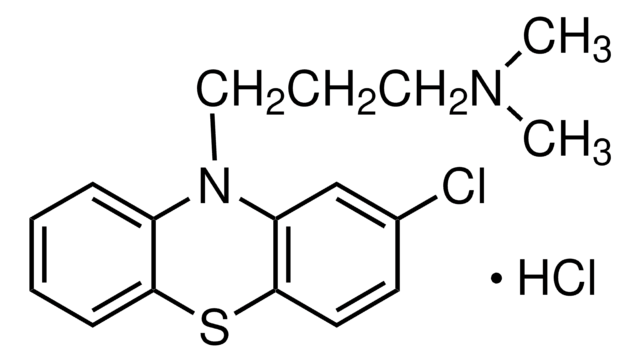Kluczowe dokumenty
SML0353
Azimilide dihydrochloride
≥97% (HPLC)
Synonim(y):
1-[[[5-(4-Chlorophenyl)-2-furanyl]methylene]amino]-3-[4-(4-methyl-1-piperazinyl)butyl]-2,4-imidazolidinedione dihydrochloride
About This Item
Polecane produkty
Poziom jakości
Próba
≥97% (HPLC)
Formularz
powder
warunki przechowywania
desiccated
kolor
white to beige
rozpuszczalność
DMSO: 1 mg/mL, clear (warmed)
temp. przechowywania
2-8°C
ciąg SMILES
Cl.Cl.CN1CCN(CCCCN2C(=O)CN(\N=C/c3ccc(o3)-c4cccc(Cl)c4)C2=O)CC1
InChI
1S/C23H28ClN5O3.2ClH/c1-26-11-13-27(14-12-26)9-2-3-10-28-22(30)17-29(23(28)31)25-16-20-7-8-21(32-20)18-5-4-6-19(24)15-18;;/h4-8,15-16H,2-3,9-14,17H2,1H3;2*1H/b25-16-;;
Klucz InChI
SUHOTCCGXXEWJN-DSHYBBOZSA-N
Zastosowanie
Działania biochem./fizjol.
Cechy i korzyści
Hasło ostrzegawcze
Danger
Zwroty wskazujące rodzaj zagrożenia
Zwroty wskazujące środki ostrożności
Klasyfikacja zagrożeń
Acute Tox. 3 Oral
Kod klasy składowania
6.1C - Combustible acute toxic Cat.3 / toxic compounds or compounds which causing chronic effects
Klasa zagrożenia wodnego (WGK)
WGK 3
Temperatura zapłonu (°F)
Not applicable
Temperatura zapłonu (°C)
Not applicable
Wybierz jedną z najnowszych wersji:
Certyfikaty analizy (CoA)
Nie widzisz odpowiedniej wersji?
Jeśli potrzebujesz konkretnej wersji, możesz wyszukać konkretny certyfikat według numeru partii lub serii.
Masz już ten produkt?
Dokumenty związane z niedawno zakupionymi produktami zostały zamieszczone w Bibliotece dokumentów.
Produkty
Sigma-Aldrich offers many products related to potassium channels for your research needs.
Nasz zespół naukowców ma doświadczenie we wszystkich obszarach badań, w tym w naukach przyrodniczych, materiałoznawstwie, syntezie chemicznej, chromatografii, analityce i wielu innych dziedzinach.
Skontaktuj się z zespołem ds. pomocy technicznej









